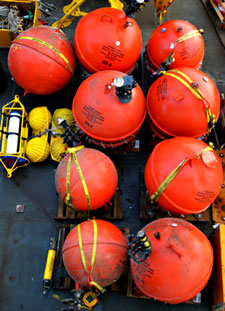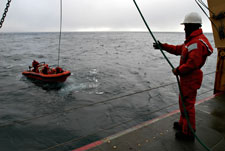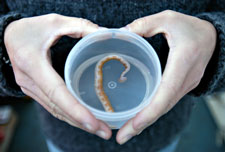 |
 |
 |
| The deck is getting crowded with mooring buoys! Next week they start going back into the water. |
Click
to enlarge
|
 |
 |
| Marine Science Technician Suzanne Scriven lets out a line to the waiting small boat during the ARP recovery. |
Click
to enlarge
|
 |
 |
| Sarah Zimmermann holds a hitchhiking worm that we found stuck to a mooring. Both ends of the worm have large suction cups. |
Click
to enlarge
|
Daily Update
Calendar
Dispatch 18 - September 27, 2003
By C. A. Linder
Weather conditions: Overcast skies, 30 kt winds, 1-2 ft seas,
air temperature 28°F
Clean Sweep
Our break in the weather came right on cue this morning, and the
mooring team was ready to go. Right after breakfast, the last deep
mooring was released and quickly recovered. We then proceeded immediately
to the site of the Acoustic Recording
Package (ARP) and released it. There were some tense moments
on the bridge as a fog bank began to roll in while we waited for
the buoys to appear. Luck was with us, though - the ARP popped up
right in front of the ship. A zodiac was put in the water, and the
small boat team hooked a line to the top of the ARP. Then it was
a simple matter to reel in the line and haul
the several hundred pound mooring on board. This afternoon the
shallowest, and final, mooring was picked up, making the mooring
marathon a complete success. The instruments were immediately stripped
off and checked. Bob Pickart sat in stunned silence when Sarah Zimmermann
and Ryan Schrawder broke the news - every instrument on the picket
fence had collected more than a year's worth of data! Bob was prepared
for a significant instrument failure rate, so this clean sweep was
absolutely astounding news! This data will provide us with a detailed
look at how the water properties and currents are changing over
a full year across the shelfbreak. Never before has this kind of
a dataset been collected in the Arctic.
After lunch, the Chief Engineer, Lieutenant Commander Gregory Stanclik,
took some science party members on a whirlwind tour
of the ship's massive engine rooms. We started with the Healy's
massive generators, which provide electricity to the propellers
and for the ship's general needs. When the generators are running
at maximum capacity (for heavy icebreaking), LCDR Stanclik told
us the Healy could "provide electricity for half of Cape
Cod!" From there we visited the ultra-modern engine
control room, which looks like something out of a Star Trek
set. Due to the many automated features, the Healy's engines
can be operated by only two watchstanders. In comparison, older
icebreakers require about 4 times as many personnel to keep the
engines running smoothly. After clambering up, down, and through
strange passageways for about an hour, I realized that before this
tour I had probably only seen 20% of the ship! The mind-boggling
array of electrical lines and motors had our heads spinning. It
gave me a new appreciation for just how complex this ship is, and
how different from the wooden whaling ships that used to ply these
waters less than 100 years ago.
Here are two questions from Mr. Jarvi's 5th grade class at Varnum Brook Elementary School.
Question: Have you seen animals hunting?
Answer: I can think of two instances where we have
observed animals hunting. The first time was on September
15th. We had just entered a thick mass of ice floes, and the
first thing we saw in the distance was a brownish lump resting on
an ice floe. As we got closer, we discovered that it was the body
of a young walrus! The two polar bears circling the ship had evidently
recently killed the walrus - we had interrupted their meal. Judging
from the numerous bloodstained ice floes in the area, this was a
popular feeding site for these two particular bears. They certainly
looked quite fat and happy! The second
time we observed feeding behavior was also in mid-September. A squawking
flock of kittiwakes pursued the ship
for several days, catching arctic cod in our wake. We also observed
their entertaining "dive-bomber" feeding syle last
year.
Question: What is the rarest animal you have seen up there?
Answer: That's a tough question... We have seen
polar bears and one walrus, which are actually quite commonly seen
along the ice edge. I have to say the biggest surprise for me was
the short-eared owl that visited us.
While I don't think short-eared owls are particularly rare, I think
it is unusual to see them at sea. There are two possible explanations
as to how the owl happened to visit us out in the middle of the
Chukchi Sea. One is that the owl got blown offshore by some strong
winds, and was trying to find his way to land. The other is that
the owl was on his way from the Alaskan mainland to an island -
arctic owls have been known to fly from island to island in the
Arctic eating small arctic mice called lemmings.
For the next couple of days we will be preparing the mooring instruments for another year under the ice. In the meantime, we will continue sampling with the CTD and collecting bottom map and current data. Don't forget to visit the image gallery to see more photos of Arctic oceanograpy in action.
 Previous
Dispatch Next Dispatch Previous
Dispatch Next Dispatch

Back to
Calendar
|




